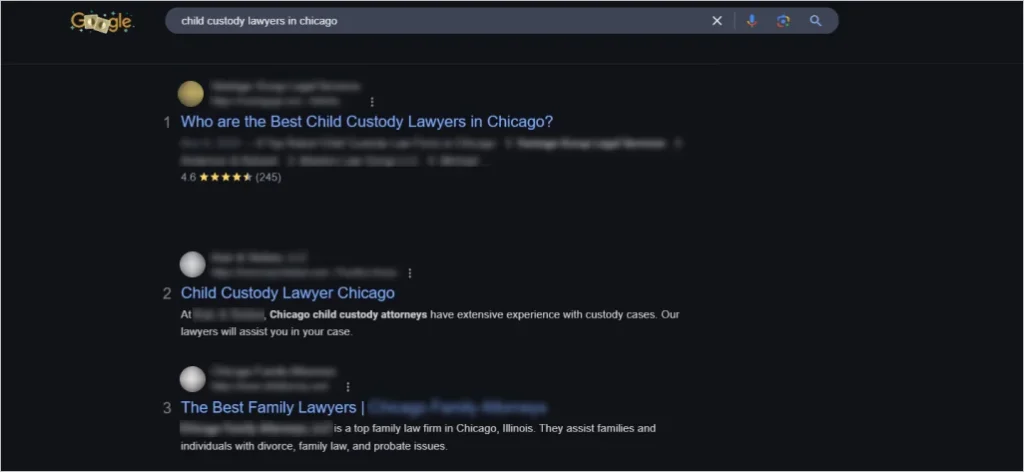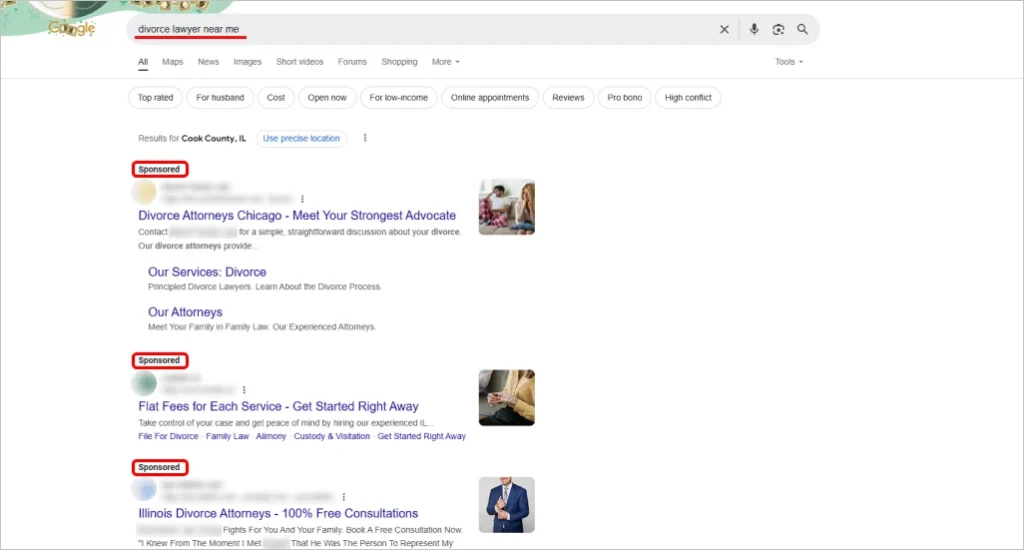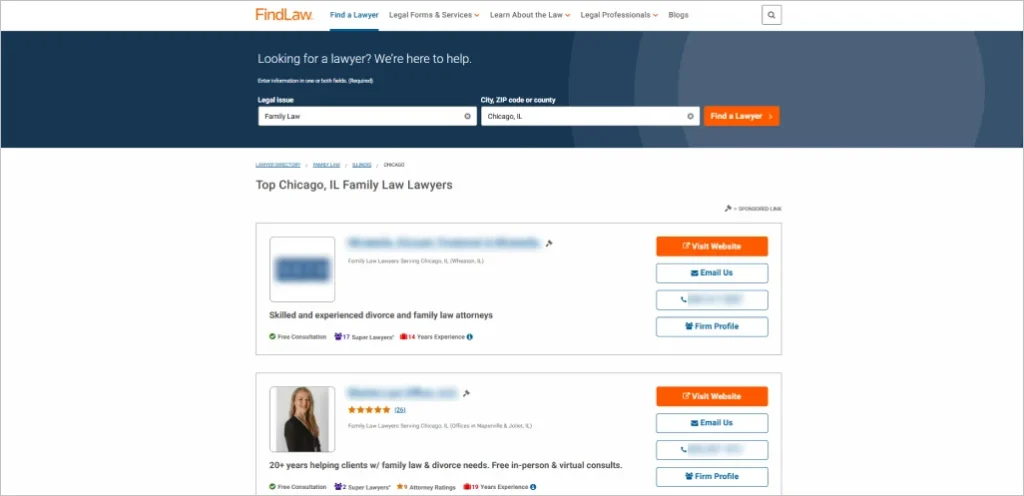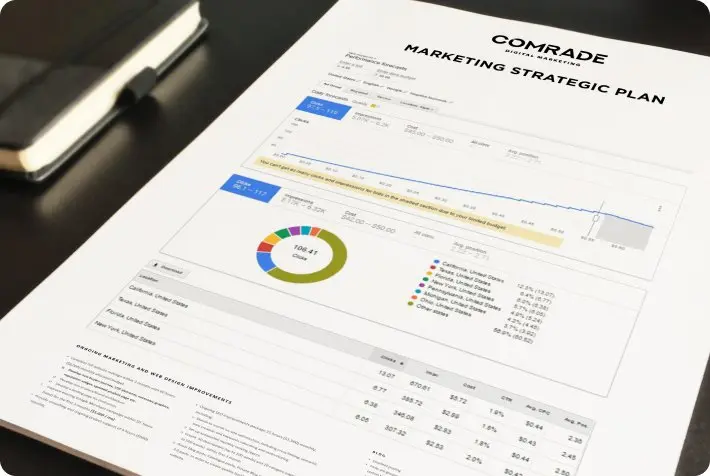Family law isn’t just legal work — it’s deeply personal. When someone is facing a messy divorce or stressful custody battle, they’re overwhelmed, vulnerable, and desperate for a lawyer they can trust.
But trust isn’t just built in the courtroom — it starts before they even call you. It starts online.
Is your digital marketing strategy helping you build trust and attract high-quality clients? If not, you’re losing revenue, period. With 97% of people looking up local businesses online, the path forward is clear: Be visible and offer value. To get started, we recommend these 7 proven digital marketing tactics designed for growth-focused family attorneys.

7 Creative Marketing Ideas for Family Law Firms
Is your goal to bring in high-quality family law clients on a steady basis?
Then, you must remember that it’s not just about your expertise as an attorney in family law. It’s not even just about displaying empathy to assure prospects. It’s about making sure the right people find you at the right time. That’s where digital marketing comes in.
In this section, we dive into 7 marketing tactics that will help your firm stand out, build trust, and fill your caseload with clients — month after month, year after year.
On a higher level, your law firm’s digital marketing strategy should look something like this:
- SEO (Local & Organic) to rank higher and attract more clients
- Advertising (Google Ads, Social Media, Directories) to gain instant visibility
- Legal Directories (Avvo, Justia, FindLaw) to boost your credibility and get leads
- Social Media (Facebook, LinkedIn, Instagram, YouTube) to engage and build trust
- AI Search (ChatGPT, Perplexity, Jiminy) to stay visible in AI-driven searches
- Referrals & Networking (Local Events) to turn connections into clients
- Retargeting Ads (Google & Facebook) to recapture lost leads
- Conversion Rate Optimization (CRO) to turn visitors into clients
- Client Segmentation & Targeted Messaging to land the right cases
- Community Outreach & Local Media Presence to enhance your local reputation
- Real-World Success Stories to show proof of real results
Find out how to attract clients as a lawyer and boost your firm’s success – read our latest blog post now!
1. SEO for Family Law Firms: A Long-Term Lead Generation Strategy
SEO is one of the most powerful lead generation tools for family law firms, but it’s a long-term investment that requires a strategic approach. To succeed, you need to focus on two key areas:
A. Local SEO: Ranking in Google’s “Near Me” Searches
When someone searches for “family law attorney near me” or “child custody lawyer in [city],” is your firm front and center or is it buried beneath your competitors?
If it’s the latter, you may have a problem.The proof is in the numbers: The first organic search result gets 31.7% of clicks on search engines, while the tenth position garners only 3.1% of clicks.

So how do you nab a prime spot on search engines?
Google Business Profile (GBP) Optimization
- Ensure your Name, Address, and Phone (NAP) details are accurate and consistent across all directories.
- Add FAQs and client testimonials to showcase your expertise and build trust.
- Post regular updates, client reviews, and case study highlights to keep your GBP active and relevant.
Comrade’s Key Takeaway
Nothing builds confidence faster than real testimonials from clients who have successfully navigated their legal troubles with your help.
Think about it: when was the last time you clicked on something with a 2-star rating? Probably never. Now ask yourself — what’s your law firm’s online reputation? If potential clients see few reviews or negative feedback, they won’t take the risk.
Positive reviews, case studies, testimonials, and trust badges validate your expertise and turn hesitant prospects into confident clients.
Key Local Ranking Factors
- Citations & Directories – Get listed in authoritative legal directories like Avvo, FindLaw, and Justia to improve credibility.
- Client Reviews – Google rewards law firms with frequent, high-quality reviews so encourage satisfied clients to leave feedback.
- Geographically Relevant Content – Create location-specific landing pages for each practice area to rank in multiple cities and regions.
Amplify your content strategy and rank higher in searches with our guide on Local SEO for lawyers.

B. Organic SEO: Building Authority & Visibility
But remember, local SEO is not enough. Ranking in local searches is a great start, but it only gets you so far.
To consistently attract high-intent leads and establish authority, your website needs to rank well in Google’s organic search results.
An organic search result appears below Google’s paid ads, ranking based on relevance and credibility rather than ad spend.
Here’s what it takes to rank higher and drive more qualified traffic:
- Content Strategy – Publish blog posts, FAQs, and in-depth legal guides answering common client concerns (e.g., How is child custody decided?).
- On-Page Optimization – Optimize meta descriptions, keyword usage, and internal linking to improve search visibility.
- Backlink Building – Earn high-authority backlinks from legal directories, industry blogs, and news sites to boost credibility.
- Technical SEO – Ensure you have a fast-loading, mobile-friendly, and well-structured website to further boost your rankings and conversions.
A strategic, well-optimized website doesn’t just help people find you — it helps them trust you. Get it right, and your website becomes your firm’s most powerful marketing tool, working 24/7 to bring in new cases.
Wondering what the best family law websites have in common? Dive into our article to find out how you can create a standout site!
2. Conversion Rate Optimization (CRO) for Family Law Websites
Getting traffic to your website is only half the battle. If visitors don’t take action — whether it’s calling, booking a consultation, or filling out a form — you’re losing potential clients.
That’s where Conversion Rate Optimization (CRO) comes in. By removing friction, guiding visitors toward action, and building trust, you increase the chances of turning clicks into consultations.
Best Practices for Higher Conversions:
- Strong Call-to-Action (CTA) Buttons – Use clear, action-driven CTAs like “Book a Free Consultation” or “Call Now” to guide visitors toward the next step.
- Live Chat & AI Chatbots – Engage visitors immediately to answer questions and capture leads before they leave your site.
- Mobile Optimization – With over 60% of searches happening on mobile, your site must be fast, responsive, and easy to navigate on any device.
- Trust Signals Matter – Display client reviews, case results, and professional affiliations prominently to reassure potential clients and build credibility.
Comrade’s Key Takeaway
Your website shouldn’t just look good — it should be built to convert. Make every click count by removing friction and making it easy for clients to contact you.
3. Advertising: The Fastest Path to New Clients
Want leads immediately instead of waiting for SEO to kick in? Paid advertising puts your firm in front of high-intent clients instantly. Whether it’s Google, social media, or legal directories, smart ad strategies bring in the right cases fast.
Here’s how to navigate paid ads for lawyers:
1. Google Ads (PPC): Capture High-Intent Searches

- Target the right keywords – People searching for “divorce lawyer near me” or “child custody attorney [city]” are ready to hire. Show up at the top.
- Use geo-targeted ads – Focus your ads on specific cities, counties, or zip codes where you want to attract clients.
- Optimize landing pages – Design pages with clear messaging, strong CTAs, and trust signals to turn visitors into booked consultations instead of lost opportunities.
2. Social Media Ads: Reach & Retarget the Right Audience
- Target by demographics & interests – Facebook & Instagram let you reach people based on age, location, and life events.
- Retarget website visitors – Someone visited your site but didn’t call? Show them a reminder ad to bring them back.
3. Legal Directory Ads: Get Seen Where Clients Are Searching
Many people turn to trusted legal directories before hiring an attorney. Paid placements on these platforms can significantly boost your visibility and lead flow.

Here are the best directories for lawyers to advertise on:
- Avvo
- Super Lawyers
- Justia
- FindLaw
- Nolo
- Martindale-Hubbell
Bottom Line? Advertising cuts through the noise and gets your firm in front of ready-to-hire clients fast.
Not sure how to make paid ads work for you? We’re here to help! Get clients faster with an expert PPC ads agency.
4. Client Segmentation & Targeted Messaging
Not all family law clients are the same. A divorce client has different concerns than a child custody client, and your marketing should reflect that. Generic messaging won’t cut it — personalization is key to attracting the right clients.
How to Segment & Personalize Your Marketing:
- Landing Pages & Ads for Different Clients – Create separate pages for divorce, custody, alimony, and other practice areas to address each client’s unique concerns.
- Targeted Google Ads & Retargeting – Customize messaging for different legal needs to make your ads more relevant and effective.
- Email & Social Media Personalization – Send content that speaks directly to specific client concerns, rather than using one-size-fits-all messaging.
Comrade’s Key Takeaway
Family law marketing must be specific and intentional — broad messaging simply won’t resonate. The more tailored your approach, the higher your chances of converting leads into clients.
5. Be Seen, Trusted, and Remembered: The Power of Community & Local Media
People hire attorneys they know and trust — and nothing builds that trust faster than being active in your community.
Whether it’s hosting free legal workshops, partnering with local organizations, or being featured as a legal expert on the news, community involvement puts your firm front and center when potential clients need you the most.
Here’s how to use local outreach and PR to establish credibility and attract more clients:
1. Active Community Participation Builds Trust and Generates Leads
- Host Free Legal Workshops & Q&A Sessions – Become the go-to legal expert in your area by offering free educational events on family law topics. Whether it’s “How to Navigate Child Custody Battles” or “Your Rights in a Divorce,” these sessions position your firm as knowledgeable, approachable, and ready to help. When people need legal guidance, they’ll remember the attorney who educated them first.
- Partner with Local Organizations – Build relationships with women’s shelters, parenting groups, and divorce support organizations. These partnerships reinforce your commitment to the community and open the door to referrals from trusted sources. When these organizations recommend an attorney, their clients listen.
- Show Up at Local Events – Attend and engage in community fairs, charity events, and local gatherings. Putting a face to your firm fosters credibility and connection. People are more likely to call an attorney they’ve met, seen, or heard speak — make sure that attorney is you.
2. Leveraging Local Media for Client Generation
- Contribute Articles to Local News Outlets: Write guest articles on family law for local publications to showcase your expertise to a broader audience, positioning your firm as a thought leader.
- Show up as a Legal Expert: Offer your insights on divorce and custody laws to local news stations. When you’re featured as an expert, your firm’s credibility is enhanced and this exposes you to potential clients seeking informed legal counsel.
The bottom line? Engaging in community outreach and local media builds trust and attracts clients who value a lawyer invested in their community. When people see your commitment firsthand, they’re more likely to choose you when they need legal help.
6. Social Media & Video Marketing: Turning Engagement into Clients
With over 3 billion active users on Facebook alone, social media marketing for lawyers is no longer optional, it’s essential for attracting clients and establishing credibility.
But here’s the mistake most attorneys make: they sporadically post on platforms like Facebook, LinkedIn, or Instagram — with no strategy or schedule — hoping to get leads and clients. Are you making this same mistake?
If so, you need to strongly consider creating a social media plan, actively engaging your audience, and delivering valuable content on a regular basis. Here’s how:
A. Social Media Presence: Where to Show Up & What to Share
Best Platforms for Family Lawyers
- Facebook – Great for community engagement, sharing legal tips, and building trust.
- LinkedIn – Ideal for networking with professionals and referral partners.
- Instagram – A storytelling platform for visual content, client testimonials, and engagement.
What to Post:
- Legal Tips & Q&A Sessions – Short, informative posts answering common legal concerns.
- Client Testimonials – Build credibility with success stories.
- Family Law Case Studies – Show how you’ve helped past clients navigate tough situations.
- Infographics & Quick Guides – Leverage bite-sized, easy-to-digest legal information.
Comrade’s Key Takeaway
81% of attorneys use LinkedIn for professional purposes, highlighting its importance in networking and building credibility.
B. YouTube & Video Marketing: Reach More Clients Where They Search

YouTube is the second-largest search engine and an untapped goldmine for law firms.
If a picture is worth a thousand words, a video is worth a million. Video marketing for law firms lets you connect with potential clients on a deeper level.
Consider this: websites with video content are 53 times more likely to reach the front page of Google search results. And viewers retain 95% of a message when they watch it in a video, compared to 10% when reading it in text.
Family law is emotional, and people want to work with an attorney they feel comfortable with. A well-crafted video can humanize your brand, and provide insights into how your firm handles sensitive legal matters.
Best Video Content Ideas:
- Answer Common Legal Questions – Titles like “How does child custody work in [state]?” rank well and attract organic traffic.
- Client Success Stories – Use video testimonials to make a powerful impact and boost your credibility.
- Explainers & Legal Guides – Leverage short, clear breakdowns of divorce, child support, custody, and other family law topics.
Social media and video marketing humanize your brand, position you as an authority, and keep your firm top-of-mind when clients need help.
The bottom line is: social media isn’t just about likes — it’s about building relationships and trust. Show up consistently, provide value, and watch your engagement (and client inquiries) grow.
7. Real-World Success Stories
Potential clients don’t just want promises — they want proof.
Showing real case studies of how your firm has successfully handled cases builds trust, credibility, and confidence in your ability to deliver results.

Think about it: when prospects see concrete examples of wins, they’re far more likely to choose you over a competitor.
Example Case Studies for Family Attorneys:
- Winning a High-Conflict Custody Battle
A mother feared losing custody to her financially stronger spouse. We built a case around child well-being, stability, and expert testimony, leading to a primary custody win. - Securing a Favorable Divorce Settlement
A high-net-worth client was worried about losing assets in a divorce. Through forensic accounting and strategic negotiations, we secured a fair asset split and alimony agreement. - Defending Against False Domestic Violence Claims
A client was falsely accused of abuse during divorce proceedings. We uncovered inconsistencies, presented key witnesses, and had the case dismissed, preserving custody rights.
Why It Works: Case studies create an emotional connection as potential clients see themselves in these stories. It’s no longer about what you “can” do — it’s about what you’ve already done. Instead of wondering if you’re the right attorney, prospects have proof that you are.
Don’t Let Clients Slip Away — Take Action Today
Every day you neglect your marketing, clients are clicking on another attorney’s website, and hiring the lawyer who showed up first.
You’ve built a practice that truly helps families — now it’s time to make sure potential clients know about it.
At Comrade Digital Marketing, we specialize in helping family law firms rise above the noise, build trust, and attract high-value clients through expert family lawyer marketing services.
From SEO and PPC to web design, and social media, we take the guesswork out of digital marketing — so that you can focus on what you do best: winning cases and changing lives. The time to act is now. Get in touch today and take the first step toward growing your family law firm.

Your no-obligation free Growth Plan:
✔ Analyzes your website & SEO performance
✔ Identifies missed opportunities for leads
✔ Builds a roadmap to increase your ranking & conversions
